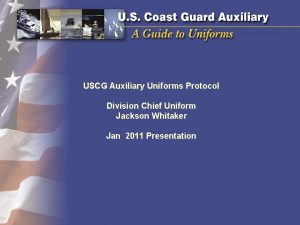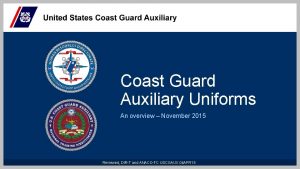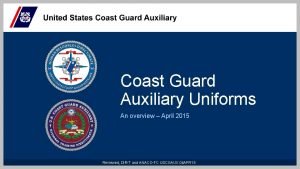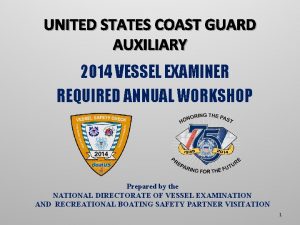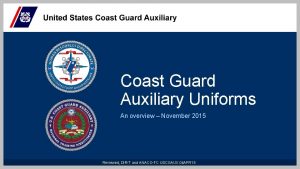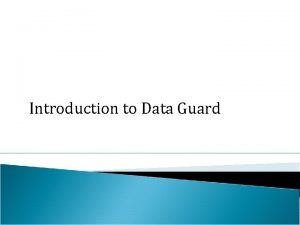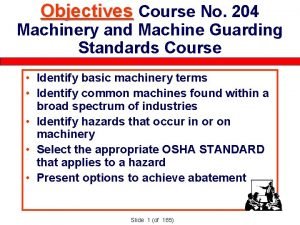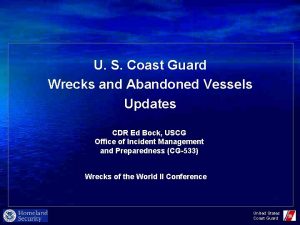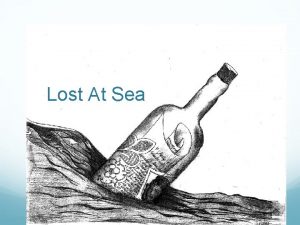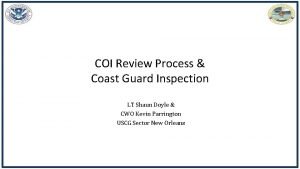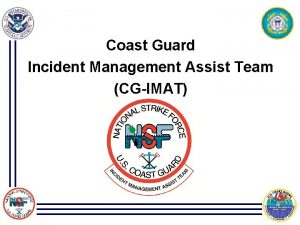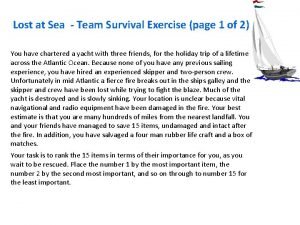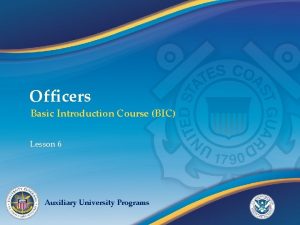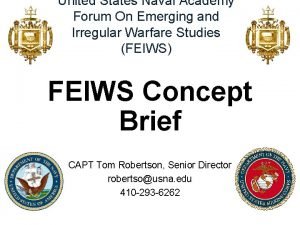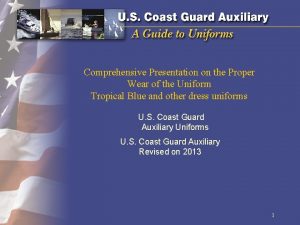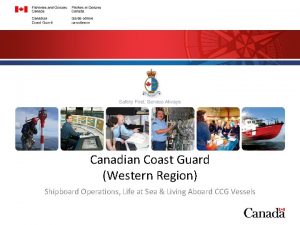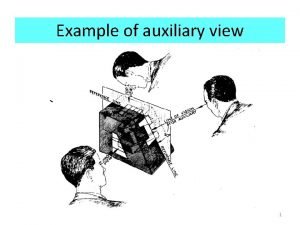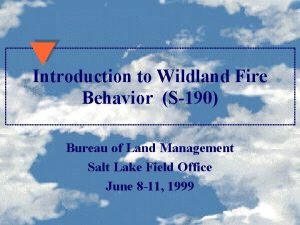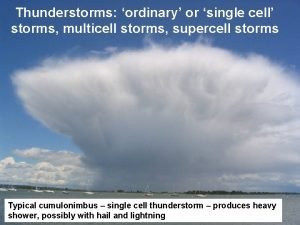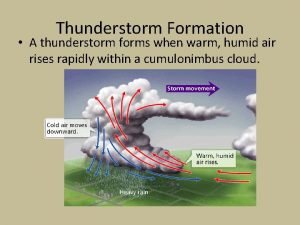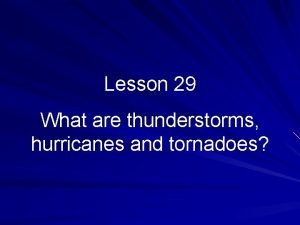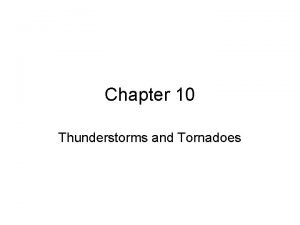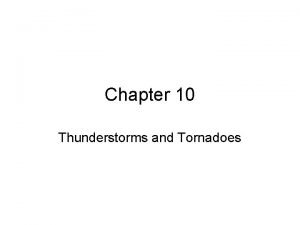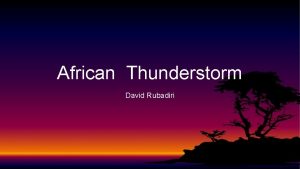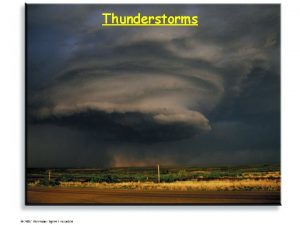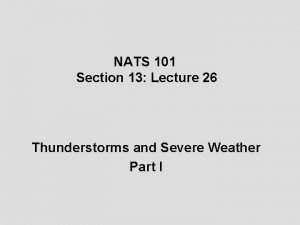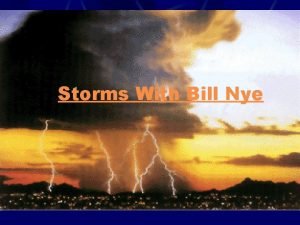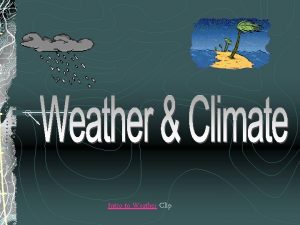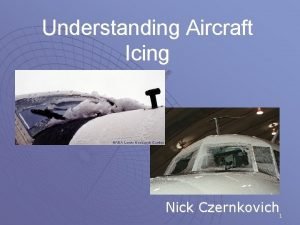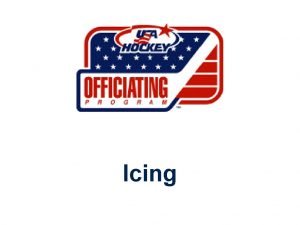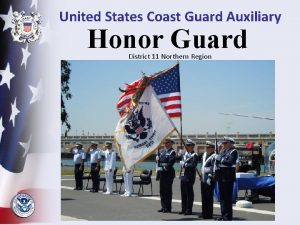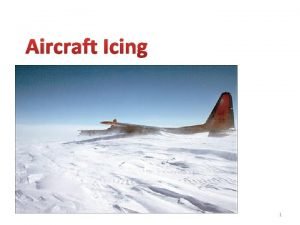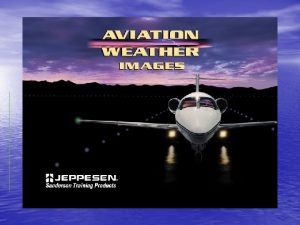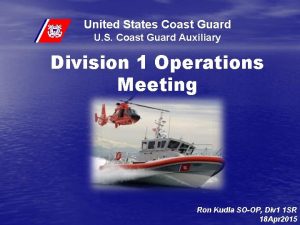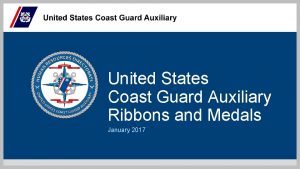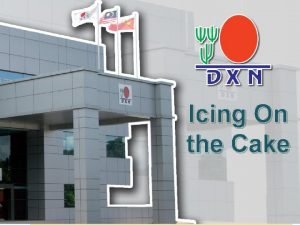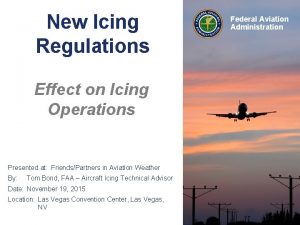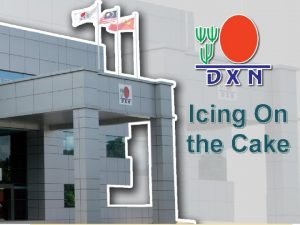Aircraft Icing and Thunderstorms US Coast Guard Auxiliary














































- Slides: 46

Aircraft Icing and Thunderstorms US Coast Guard Auxiliary

Part 1 Icing

Categories of Icing �Structural Icing � Forms on the surface of the airframe �Induction Icing � Forms in air intakes of engines �Instrument Icing � Forms on pitot tube and other exterior instruments

Necessary Conditions � Temperature of 0 Celsius or colder � Supercooled liquid droplets � Liquid cloud or precipitation droplets at below freezing temperatures � Wet snowflakes � Snowflakes at temperatures near 0 C � Mixture of ice particles and supercooled water droplets � When the supercooled liquid hits the airframe, the airframe acts like an ice condensation nuclei and allows the liquid to rapidly freeze

The Cause of Icing �NOT caused by ICE in clouds. �Is caused by “Super-cooled” liquid water droplets � Strike the leading edge of an airfoil � Freeze on impact

Supercooled Droplets – Why do they exist? � Ice Condensation Nuclei typically do not exist at temperatures warmer than -10 C � Ice Condensation Nuclei levels are present at 50% between -10 C and -14 C � Ice Condensation Nuclei are present nearly to 100% by -20 C � Several types of clay particles are common ice nuclei, silver iodide is another.





ICING INTENSITIES TRACE PERCEPTIBLE, NO SIGNIFICANT ACCUMULATION LIGHT A - MODERATE - SIGNIFICANT ACCUMULATION FOR SHORTER PERIODS OF FLIGHT SIGNIFICANT ACCUMULATION FOR PROLONGED FLIGHT (OVER 1 HOUR) SEVERE RAPID, DANGEROUS ACCUMULATIONS

CLEAR ICING FAVORABLE CONDITIONS LARGE DROPLETS IN CUMULIFORM CLOUDS OR FREEZING RAIN TEMPERATURES 0°C TO -20°C


Clear Icing - Characteristics �Rapid accumulation � Droplets are large � Droplets are highly concentrated �Smooth surface �Hard �Difficult to remove

RIME ICING FAVORABLE CONDITIONS SMALL SUPERCOOLED DROPLETS IN STRATIFORM CLOUDS TEMPERATURES 0°C TO -20°C

Rime Icing � White, frosty appearance � Favorable conditions � Small water droplets � Stratiform clouds � Temperatures 0 to -20 C � Formation Process � Droplets freeze on impact � Air is trapped between frozen particles

Rime Icing - Characteristics �Accumulates more slowly than clear icing � Droplets are smaller � Droplets are less concentrated �Irregular, pebble-like surface �Structurally weaker than clear icing � Effect of trapped air


Rime Icing Gray is region where air is stagnant � Tends to form at leading edge of airfoil � More easily for de-icing equipment to remove Rime • Compare with “horns” of Clear icing Clear

MIXED ICING FAVORABLE CONDITIONS LARGE AND SMALL DROPLETS COEXIST LIQUID AND FROZEN PARTICLES COEXIST WET SNOW FREEZING TEMPERATURES

Mixed Icing � Glossy white appearance � Associated with strong upward motion � Favorable conditions � Large and small droplets coexist � Liquid and frozen particles coexist � Wet snow � Freezing temperatures (Often much colder than -10 C) � Formation Process � Combines clear and rime icing processes and/or wet snowflakes

Mixed Icing - Characteristics �Rapid accumulation � Particles are large � Particles are highly concentrated �Rough surface � Creates turbulent flow over wing � Most effective in reducing aerodynamic efficiency (turbulent flow over wing reduces lift) � Difficult to remove


Part 2 Thunderstorms

The Dangers in and Near Thunderstorms �Wind shear �Turbulence �Icing �Lightning �Hail

TURBULENCE and WIND SHEAR CAT BLOWOFF ROLL CLOUD WIND SHEAR TURBULENCE FIRST GUST

GUST FRONT

STORM DIRECTION Cb Cb First gust, windshear turbulence, and rapid wind changes up to about 6000’ A. G. L. ROLL CLOUD Clear or possibly wind blown dust within turbulent air. Up to 10 miles. Up to 100 Kts 150 ft. A. G. L.

Ingredients for Thunderstorm Development - Moisture Low and Mid Level Moisture High Humidity

Thunderstorm Ingredients - Instability �Unstable � Heat rises � Moisture Condenses into clouds as air rises � Common with Low Pressure Systems �Stable � Air sinks � Commons with High Pressure Systems

Thunderstorm Ingredients – Source of Lift Warm /Cold Fronts Thunderstorm Outflow Boundaries Lake Breezes

Thunderstorms Ingredients �Varying degrees of the 3 main elements will affect strength of thunderstorms �Additional ingredients that affect strength of thunderstorms include � Wind Shear � Location of Jet Streams � Large Scale Weather Pattern

Thunderstorm Development – Three Stages �Cumulus �Mature �Dissipation

Basic Thunderstorm Evolution �Rising currents of air are referred to as an Updraft. When combined with sufficient moisture, towering cumulus clouds develop.


Copyright Charles A. Doswell, III

Photo courtesy of Jimmy Deguara Australiasevereweather. com

Fair Weather Cumulus – Not Enough Instability or Lift to Generate Thunderstorms

Basic Thunderstorm Evolution � Moisture will condense out of the cloud causing rain, thunder, and lightning. This marks the Mature Stage of the thunderstorms when the updraft and downdraft coexist together.

Basic Thunderstorm Evolution � The downdraft will eventually overcome the updraft, causing the thunderstorm to weaken. The thunderstorm is now in the Dissipation Stage. 40

41

42

Special Types of Thunderstorms � Multi Cell Cluster – These are a family of single cell storms occurring at the same time but in different stages of their lifecycle. � These typically occur in moisture rich unstable environments.

Special Types of Thunderstorms � Multi Cell Line/Squall Line – These are storms organized into a line, often being long lived. � These typically occur in an atmosphere high in instability and wind shear (strengthening winds aloft)

Special Types of Thunderstorms � Super Cell – A long lived single cell storm with a rotating updraft. Typically the strongest of the types. � These occur in an atmosphere high in instability and directional wind shear (strengthening and turning winds aloft)

THE END
 Uscg uniforms
Uscg uniforms Coast guard auxiliary benefits
Coast guard auxiliary benefits Coast guard auxiliary uniforms
Coast guard auxiliary uniforms Coast guard uniform distribution center
Coast guard uniform distribution center Vessel examiner test answers
Vessel examiner test answers Coast guard auxiliary odu uniform
Coast guard auxiliary odu uniform Seljin
Seljin Affirm and noaffirm in oracle data guard
Affirm and noaffirm in oracle data guard Oracle coast guard
Oracle coast guard Upper hood guard and full diameter saw guard
Upper hood guard and full diameter saw guard Upper hood guard and full diameter saw guard
Upper hood guard and full diameter saw guard Coast guard sato travel
Coast guard sato travel Coast guard
Coast guard Us coast guard navigation center
Us coast guard navigation center Hin number format
Hin number format Us coast guard academy admissions
Us coast guard academy admissions Us coast guard navigation center
Us coast guard navigation center Coast guard lost at sea ranking
Coast guard lost at sea ranking Cg 3752
Cg 3752 Coast guard imat
Coast guard imat Uscg bravo uniform
Uscg bravo uniform Uscg hin
Uscg hin Lost at the sea exercise
Lost at the sea exercise Lost at the sea ranking chart
Lost at the sea ranking chart Coast guard knots
Coast guard knots Coast guard culinary school
Coast guard culinary school Coast guard bpr
Coast guard bpr Coast guard ethos
Coast guard ethos Naval academy forum
Naval academy forum Coast guard sector columbia river
Coast guard sector columbia river Iaa billings
Iaa billings Uscg leadership competencies
Uscg leadership competencies Undress uniform procurement
Undress uniform procurement Canadian coast guard deckhand
Canadian coast guard deckhand How to draw auxiliary view
How to draw auxiliary view Three visual indicators of lightning and thunderstorms
Three visual indicators of lightning and thunderstorms List and describe the stages of a single cell thunderstorm
List and describe the stages of a single cell thunderstorm Thunderstorms form when warm, humid air rises in a
Thunderstorms form when warm, humid air rises in a What cloud types would indicate convective turbulence?
What cloud types would indicate convective turbulence? What are thunderstorms
What are thunderstorms What are thunderstorms
What are thunderstorms Multicell thunderstorms
Multicell thunderstorms Africa thunderstorm poem
Africa thunderstorm poem Squall line
Squall line Thunderstorms
Thunderstorms Bill nye thunderstorms
Bill nye thunderstorms What causes lightning brainpop
What causes lightning brainpop
